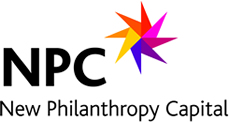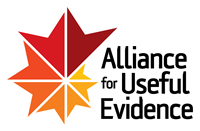Resources » Topic » Outcomes
External Databases and ResourcesImpact ReportsToolsTraining and CoursesVideos
Books and Guides
These documents explain the relationship between Social Return on Investment (SROI) and 1) Social Accounting and Audit (SAA), 2) GIIRS Ratings & Analytics (“GIIRS” stands for the Global Impact Investing Ratings System) a comprehensive, comparable, and transparent system for assessing the social and environmental impact of companies and funds with a ratings and analytics approach analogous to Morningstar investment rankings, and 3) IRIS (Impact Reporting and Investment Standards) standardized performance indicators to help an organization understand its impact in a credible and comparable way.
The CES Resource Guide: Evaluating outcomes and impact from the Charities Evaluation Services contains over 130 online and published guides, tools, discussion papers and fact sheets on all aspects of evaluation. It is designed as an interactive guide, and is a great go to resource for anyone involved with monitoring and evaluation.
The free guide contains the following dedicated sections:
- General guides and introductions to evaluation
- Assessing outcomes and impact
- Evaluation approaches and methods
- Sub-sector specific guidance
- Creative tools for engaging a range of stakeholders in monitoring and evaluation
- Useful websites
This presentation from the British Council demonstrates how they evaluate impact. It includes indicators, a logic model and examples of data collection.
This paper by Angela Kail and Tris Lumley from NPC explores what is a Theory of Change and how it can be used for strategy, evaluation and understanding outcomes.
This paper, by Andrea Westall for NAVCA’s Local Commissioning and Procurement Unit, provides an overview of the different tools and approaches that are being used and developed for measuring and evidencing how charities and community
groups create social value, and discusses the implications for these organisations.
Leap of Reason inspires leaders in the social and public sectors to take bold action to create more meaningful, measurable good for those they serve. The book is the product of decades of management insights from philanthropist Mario Morino, McKinsey & Company, and more than a dozen experts and practitioners.
External Databases and Resources
The Nonprofit Outcomes Toolbox, by Robert M. Penna, Ph.D, provides a selection of resources on outcomes.
Crisis commissions external researchers to independently evaluate our projects and the services they offer, as well as to produce good practice guides on a range of topics.
Since 1989, ORS Impact have been delivering deep value into their clients’ organisations, working together to pursue ‘the change they seek,’ and to improve their communities’ health, wellbeing, and prospects to flourish. They share these resources, with a view to building capacity in organizations doing good work around the world. Resources are on topics inclusing Theory of Change, Evaluation Practice, Outcomes and Advocacy and Policy.
Big Society Capital provides guidance, best practice advice and an outcomes matrix for social impact measurement for investors and social sector organisations.
The Global Value Exchange is an open source database of Values, Outcomes, Indicators and Stakeholders. It provides a free platform for information to be shared enabling greater consistency and transparency in measuring social & environmental values. The site empowers users by giving them a voice to share their experiences and allow them to become the ‘creators of knowledge’.
Impact Reports
Making their lives better: now, tomorrow and every day is Action for Children’s Impact Report 2014. This report draws on a wide range of evidence, using both quantitative and qualitative data and includes findings from independent evaluations, a variety of measurement tools and services funded through social investment.
Calvert Foundation’s 2013 Social Impact Report explores the impact that investors, funders, supporters, portfolio partners, and advisors have empowered them to create in 2012. Calvert Foundation works at the nexus of communities and capital, meaning their impact is both the outcomes of our lending - affordable housing units built, jobs created, etc. - and the ways that they enable people to invest in the causes that inspire them.
Uscreates Social Value Measurement Toolkit helps you to put in place what is necessary to plan and deliver an effective Social Value measurement approach. Developed in collaboration with leading companies and informed by hands-on practitioner experience, it provides tried and tested insight into how to get the most out of Social Value measurement.
The Toolkit features:
> How to define and map social value.
> How to define the right objectives, set relevant success factors, choose the right methodologies, engage stakeholders and embed your approach in your organisation
> Practical examples and what others have learnt along the way
> Video interviews with practitioners from O2, RBS and EY.
> Case studies from Sainsbury’s, Deloitte, Landmarc, Aviva and Catch22
> Downloadable tools and resources
The Value game is an online web tool for surveying your stakeholders. They will tell you the importance – expressed as a value - of what they experience as a result of using your products or services, the outcomes.
The Journey to EmploymenT (JET) framework from Inspiring Impact helps organisations that work with young people understand and measure the impact they have on the journey to employment.
The StrategicFrame, developed by the University of Sydney Business School, is an organising framework that helps coordinate the process of measuring and improving an organisation’s performance and impact.
The StrategicFrame brings the focus back to the organisation. It can be useful regardless of your organisation’s mission, size, stage of development, or time available. It can assist you develop a coherent story with sufficient context and depth to communicate your impact, incorporating multiple measurement tools (such as SROI, IRIS, Outcomes Stars or internal measures).
The outcomes matrix is a tool to help social investment financial intermediaries (SIFI’s) and social sector organisations to plan, measure and learn about their social impact. It aims to develop common ground and language for social investment and impact assessment in the social sector. The outcomes and measures are not intended to be prescriptive or exhaustive but should provide a helpful starting point for organisations to consider their social impact.
Training and Courses
The Charities Evaluation Services (CES) are leading experts on providing high quality training to help you to develop your work on monitoring, evaluation and quality improvement. CES offers a variety of training courses including courses on PQASSO, Theory of Change, outcomes, impact measurement and practical skills.
The ‘how to’ training modules from Better Evidence for a Better Start (BEBS) at Dartington describe how to apply some of the key concepts to develop a strategy for the Better Evidence for a Better Start project. The purpose of this training is to provide local coordinators with the information and skills needed to develop a strategy for their areas. The modules were presented by the Social Research Unit at the ‘how to’ training event on the 22nd November 2013.
The six modules in this training are:
- how to develop a strategy
- how to interpret the Area Wellbeing Profile
- how to interpret the ‘What Works’ data
- how to chart resources
- how to review policy
- how to monitor implementation & outcomes
Videos
This video, from The Social Investment Business (SIB) Group and the Good Analyst, explains what a Theory of Change is and how you can use it as a key step in deciding what you will need to measure to evidence your social impact, using the example of The Rooftop Garden Project.
Working Papers and Research
This report by Eibhlin Ni Ogain, Sarah Hedley and Tris Lumley presents the new suite of tools to help social investors, and those seeking social investment, that Big Society Capital commissioned using a team comprising NPC, the SROI Network and Investing for Good with the aim to embed a robust approach to impact in their work.
The tools presented here are:
- An outcomes matrix, which segments outcomes within the social welfare and environment arenas into 13 outcome areas.
- Outcomes maps, which drill into the detail of the outcomes matrix, providing overviews of the key outcomes, indicators and data sources commonly used in each of the 13 areas.
- Guidance on investor best practice.
This working paper, by Julian Cox, Matt Bowen and Oliver Kempton for New Economy, documents and discusses research work being carried out in Greater Manchester to understand and identify if it is possible to robustly value social outcomes. The research has focused on the ongoing Community Budget programmes across Greater Manchester. The paper presents a methodology for valuing social outcomes and suggests how such an approach can be used and taken forward by practitioners, commissioners, analysts and suppliers of programmes across Greater Manchester.
This paper, by Anju Malhotra, International Center for Research on Women, Sidney Ruth Schuler, JSI Research and Training Institute and Carol Boender, JSI Research and Training Institute, reviews the literature on women’s empowerment and suggests supporting empowerment both as an end in itself and a way to educational, economical and health development. It begins with a discussion of the various conceptual frameworks of women’s empowerment, and then examines the ways in which women’s empowerment projects have been implemented and measured, ending by stressing the positive development outcomes of women’s empowerment.
This report from the Centre for Social Justice is a policy report from the Social Return on Investment (SROI) Working Group chaired by Dr Stephen Brien. It argues that a core aim of government is to improve social outcomes; yet for most government expenditure the real value of outcomes is rarely considered or even understood. It shows recent governments to have placed more emphasis on the management and monitoring of public services, but it is not obvious that this has delivered better value for money – the true effectiveness of most policy is still poorly understood. If government cannot determine where public spending delivers results and where it does not, both the taxpayer and society as a whole will continue paying for ineffective and inefficient programmes.
The paper proposes a framework through which both central and local government can improve the effectiveness of public spending. This framework is based on a number of social value approaches explored in the Review. The government needs to clearly articulate outcomes, and develop the internal capability to enable timely and accurate measurement of both the outcomes delivered and the costs incurred. Outcome-based government means focusing on those initiatives that genuinely change people’s lives: more often than not, tackling root causes rather than simply treating symptoms. Changing life outcomes can transform the lives of individuals and their communities, and result in savings to the taxpayer.
This paper by Joy MacKeith from Triangle Consulting seeks to describe the development process for the Outcomes Stars as a suite of tools which are designed to simultaneously measure and support change when working with vulnerable people as service users. It describes the original process of development of the first Star, in homelessness services in the UK, and subsequent roll out to other client groups and in other countries. The paper indicates the theoretical and philosophical under-pinning of an approach which aims to embody both research and values-based practice in empowerment and respect for the individual.





